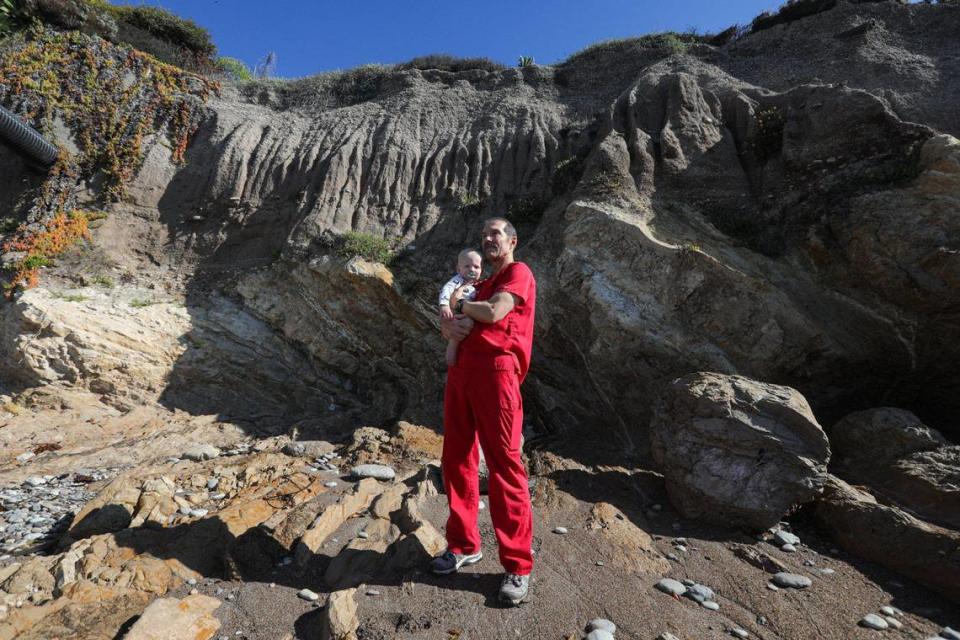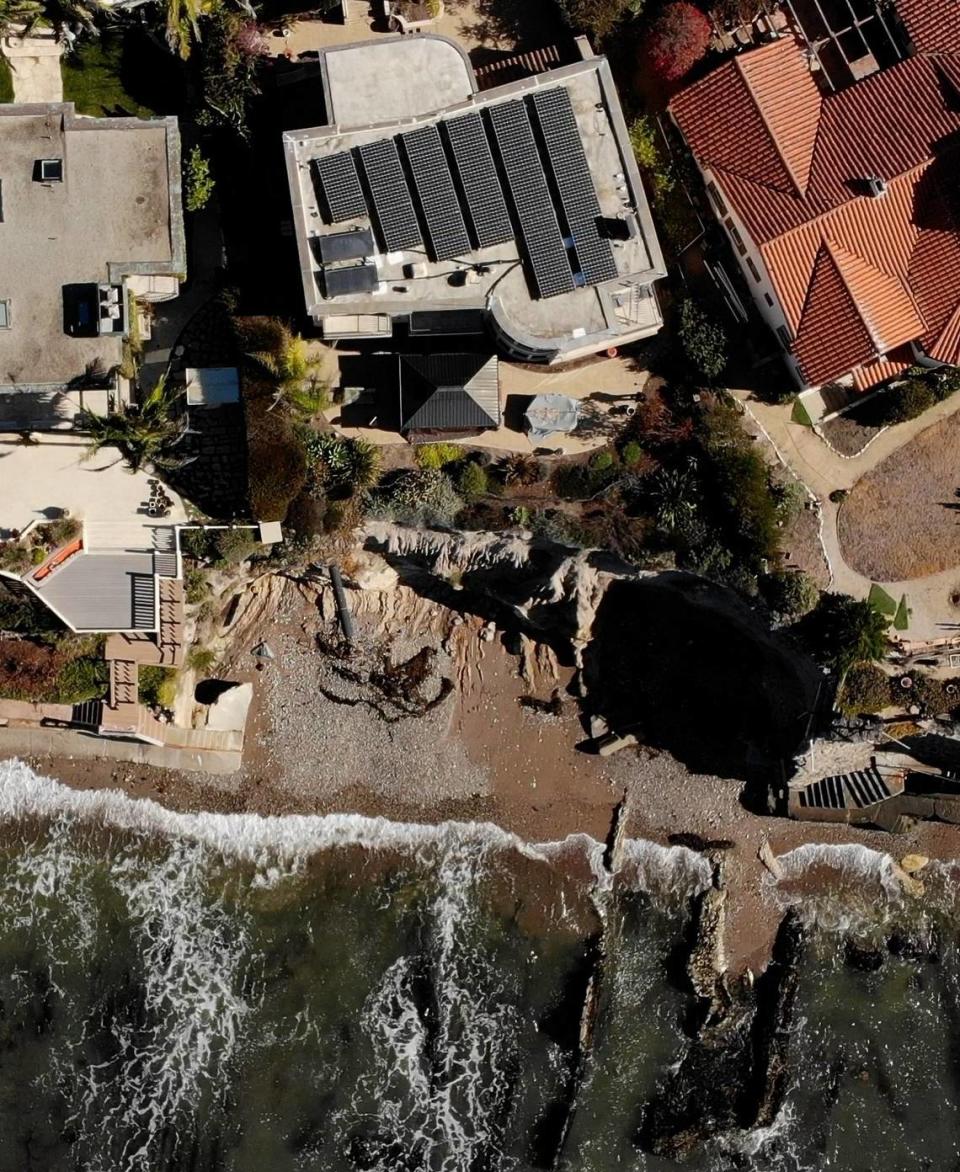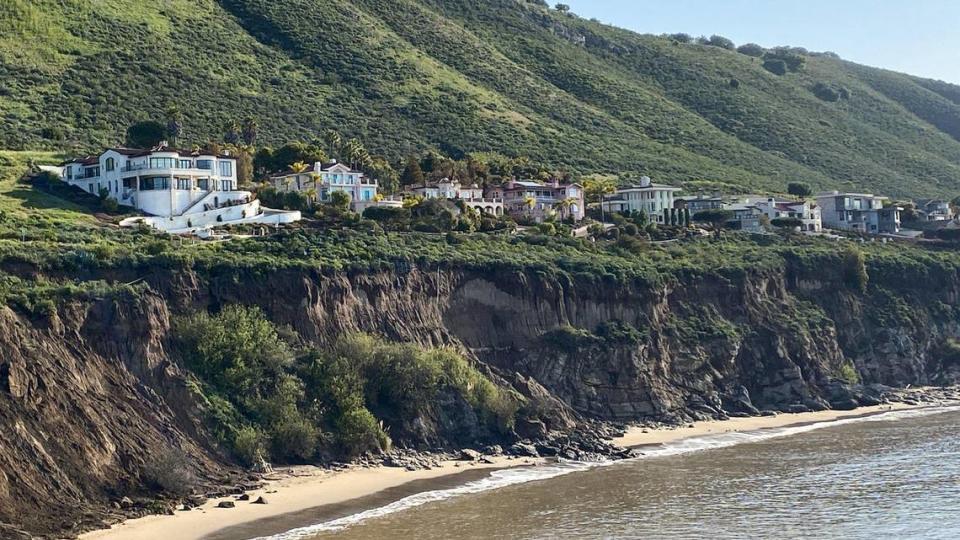Crumbling sea cliffs and coastal flooding: What rising sea levels mean for SLO County
Editor’s note: This article is the second in a four-part series exploring how climate change may reshape life in San Luis Obispo County over the next 10 to 50 years. The series will examine the existing science and evaluate the steps we can take to reverse the impacts, both as a community and as individuals.
All it takes is about 20 steps from John Okerblom’s backdoor to reach the cliff that plunges 40 feet to the Pacific Ocean.
From his kitchen table in Shell Beach, you can hear the waves crash against the rocky shoreline and gaze at the horizon from behind large windows.
It’s a stunning view. But it’s crumbling.
Okerblom’s home is one of several in the Pismo Beach area that rests on the edge of a cliff without a seawall to protect it from the unrelenting surf. From a bird’s eye view, his home looks like the gap from a missing tooth in a child’s smile — an unprotected pocket surrounded by an armored shoreline.
Okerblom, 70, knew his cliff was eroding when he built the house in 2013, but he thought he could live out his retirement in it at least. The cliff behind his home has eroded at more than five times the rate originally predicted — the edge now about 13 feet closer to Okerblom’s back door from where it was a decade ago.
“If I don’t protect this lot, this lot isn’t going to be here in a hundred years,” he said.
Because the California Coastal Commission has appealed permits from the city of Pismo Beach to build a seawall to protect his house, Okerblom said he plans to move to Washington to retire, leaving his multi-million dollar home to the next person willing to make the short-term investment.
And it will most likely be just that: short-term.
Oceans are rising globally because of melting ice caps and expanding seas as the planet’s atmosphere warms from human-caused climate change. Scientists predict seas could rise in San Luis Obispo County anywhere from half a foot to more than a foot by 2050, or up to 6.27 feet by 2100.
Such sea level rise will not only dramatically speed up cliff erosion, it will also increase the risk of frequent flooding in some areas and impact natural ecosystems that have existed in equilibrium for eons.
“A lot of our future planning focuses on sea level rise,” said Matt Downing, Pismo Beach’s community development director. “Cliffs are going to erode; lower areas are going to flood. We need to figure out how we’re going to deal with that and what our future is going to look like.”

Winter storms hint at how rising tides might impact SLO County
San Luis Obispo County will likely not see as dramatic impacts from sea level rise as other areas of the United States, such as Louisiana, where water levels are expected to rise between 1.5 to 2 feet by 2050 and cause massive swaths of the state to disappear into the sea.
But this year, the region got firsthand experience in the level of devastation climate change can inflict on communities.
Following an intense drought that shriveled reservoirs and rivers, powerful storms fueled by atmospheric rivers poured more than two feet of rain on the county in January and March, causing reservoirs and rivers to overflow.
The storm also brought high ocean tides.
The tides generated waves that broke against seawalls and beachfront stairs rarely touched by the salty water, and an unusually strong wave crashed through a home in Cambria, injuring one person inside.
The higher tides also pushed into creek lagoons, exacerbating the flooding caused by the influx of rainfall.
The rising ocean is something coastal organizations, communities, cities and the county are working to plan for to avoid devastating infrastructure and ecosystem impacts.
“We’ve always been addressing coastal hazards, which includes things like flooding and erosion,” California Coastal Commission climate change analyst Kelsey Ducklow said. “And those are the same things that are going to be exacerbated by sea level rise.”
The impacts of sea level rise in San Luis Obispo County go hand in hand with other climate change factors.
For example, in Avila Beach, much of the downtown area is prone to flooding during big storm events while tides are high.
San Luis Obispo Creek can fail to breach the sandbar into the ocean during dry periods, therefore building the lagoon up and causing water to flow back up the town’s culverts and into the streets. Higher tides push the lagoon up further, leading to the greater likelihood of flooding.
When a rainstorm comes while tides are high and the lagoon is full, even more flooding happens.
“It just needs that right combination of lack of rain and then high tides and high swells combined to push up the sandbar,” said John Waddell, deputy director of San Luis Obispo County Public Works Department. “So, over time, with sea level rise, I suspect it’s going to become more common for that area of Avila to flood.”

Erosion quickening along SLO County’s shores
San Luis Obispo County’s shoreline faces a similar predicament: A combination of drought leaves soils parched, while large storm events cause increased erosion.
As the ocean rises and waves crash against Okerblom’s seawall at his Shell Beach home more often, the problem worsens.
Okerblom’s neighbors each have seawalls to protect their homes, but those barriers are slowly being undercut by the rising ocean.
“That’s not an uncommon problem,” Downing said. “And any new seawalls are typically patchwork where there are gaps between older seawalls.”
The Coastal Commission has already denied construction of Okerblom’s seawall. Although it’s expected to be up for a second hearing this year, his hopes are low — and for good reason.
The Coastal Commission in recent decades has hesitated to approve seawalls because of the harm they pose to the natural environment.
“When you have a seawall, that forms the back part of that beach and stops any kind of natural migration,” the Coastal Commission’s Ducklow said. “If you fix that line of development, whether that’s with a seawall or if it’s with a roadway, or any kind of development, then eventually what you’re gonna see is a narrowing beach, and it’ll eventually get lost.”

The Coastal Commission requires developers to set back new homes with enough space to allow 100 years of erosion to occur before the structure is threatened by the crumbling cliff.
Okerblom thought he had that 100 years with his home, but the increased rate of sea level rise, coupled with severe storms and drought, quickened the pace of erosion.
According to Coastal Commission staff reports, erosion from the ocean waves plus runoff and groundwater seepage increased the annual erosion rate from 3.36 inches per year to 15 to 18 inches per year.
There are some developments, however, where the Coastal Commission will allow seawalls. Those include essential infrastructure that cannot otherwise be moved.
In San Simeon, the Coastal Commission is working with the community services district to eventually relocate its wastewater treatment plant.
The plant sits right on the beach, next to a seasonal stream that has formed a slight canyon from years of erosion. Although the plant is somewhat protected from waves in the near term with large rocks surrounding its base, Ducklow said the facility must be moved inland to prevent a catastrophe.
The Coastal Commission has also worked with Caltrans to move highways inland, and Amtrak to protect its tracks from falling into the ocean.
“The overall approach is: What can we do right now to make sure these things that are clearly needed for public service; public benefits, are kept safe, while at the same time planning for the long term,” Ducklow said.
SLO County cities plan for rising sea levels
Coastal cities in San Luis Obispo County have recently begun planning in earnest for rising sea levels, with funding help from the Coastal Commission.
Morro Bay, for example, completely rewrote its 32-year-old General Plan, which the City Council adopted in 2021, with a focus on how it must adjust to sea level rise.
It centers future coastal development practices around how rising seas may impact its coastal infrastructure and how things must be rebuilt, moved or changed to avoid damage and ensure its longevity.
“Certainly, we haven’t solved all of the problems yet — I mean, we’re just now starting to say, ‘Hey, there’s a problem,’” said Scot Graham, Morro Bay’s community development director. “We can’t stick our head in the sand because if we do, it’ll be too late when we have the problem.”
Drafting the plan wasn’t necessarily easy, Graham added, because the science around sea level rise has changed rapidly within the last several years.
The most current projections show sea levels could rise in San Luis Obispo County anywhere between half a foot to 1.12 feet by 2030, according to data from the National Oceanic and Atmospheric Administration.
Should climate change trends continue, sea levels could rise between 1.25 feet to 6.27 feet in the county in the following decades.
These numbers can be difficult to visualize: What does an ocean one foot higher look like in Morro Bay, or Pismo Beach, or Cambria?
Luckily, there are maps designed to show this very thing.
In a partnership with Point Blue Conservation Science, a research nonprofit organization, the United States Geological Survey created interactive maps that show where San Luis Obispo County may see increased erosion and flooding due to sea level rise.
In general, the “Our Coast, Our Future” map shows that low-lying areas of the county will likely see more flooding, cliffs will erode and many beaches will shrink as the ocean rises.
Entire homes and buildings may fall into the sea at the highest end of sea level rise predictions.
With 5.7 feet of sea level rise, historical infrastructure such as the Chapman Estate in Pismo Beach could fall into the ocean, Morro Strand Beach could be reduced to a sliver hugging the high school and homes, and the Moonstone Beach boardwalk in Cambria may be claimed by the sea.
And Okerblom’s home might as well be gone.
“Ultimately, I won’t be able to retire here,” he said, “because all the land around it is eroding away.”

